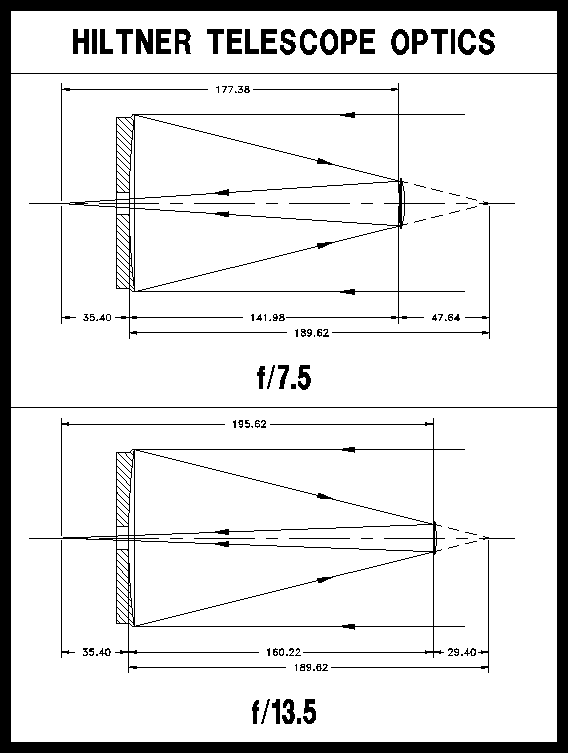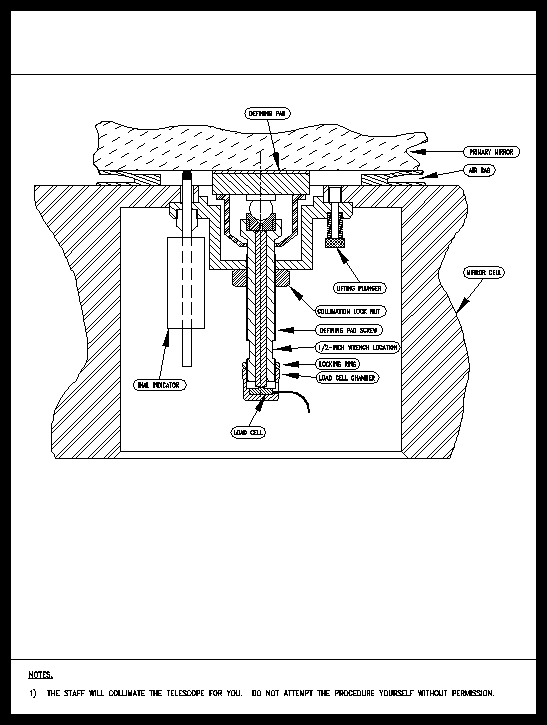3 Telescope Specifications
3.1 Historical Introduction
The telescope is named after William Albert Hiltner (1914-1991), who discovered the interstellar polarization of starlight. Hiltner was an early practitioner of precision stellar photometry, and a pioneering observer of the optical counterparts of celestial x-ray sources. For many years he was the director of the Yerkes Observatory before becoming director of the University of Michigan's Observatory, when he established the Michigan-Dartmouth-M.I.T. Observatory and realized the construction of the 2.4m reflector.
The Hiltner 2.4m Telescope is a fork-mounted equatorial telescope employing friction drives. It was designed by DFM Engineering of Colorado and built by L&F Industries of California. The optics were originally generated and polished in Tucson during 1984 and again in 1986, but were completely reworked in 1990/91 by Contraves U.S.A. of Pittsburgh, Pennsylvania.
3.2 OPTICAL SPECIFICATIONS
The Hiltner 2.4m Telescope optics are very close to a Ritchey-Chretien design with access to the f/7.5 and f/13.5* Cassegrain foci. Scaled optical diagrams are given in Figure 3.1. Access to prime focus is limited to engineering tests. Full optical specifications are given in Table 3.1.
All three mirrors are made of low expansion Cer-Vit, with a regular aluminum coating. The primary mirror has a slight turned-down edge and has been masked to a clear aperture of 2.32 m (91.5 inches) yielding an f/2.07 beam.
For the clear aperture of the primary mirror:
The performance of the primary is degraded by the introduction of the secondary and the mechanical support of the mirrors. However, on nights of excellent seeing the telescope is capable of producing stellar images of 0.7 arcseconds FWHM at visible wavelengths or better over a 10 minute integration. Stellar images with 0.4-0.5 arcseconds FWHM have been recorded in 3 minute integrations at K-band (2.2-microns).

| INCHES | METRIC | |
| f/2.07 PRIMARY MIRROR | ||
| Diameter of front face | 93.0 | 2362 |
| Clear aperture (after masking) | 91.5 | 2324 |
| Thickness | 9.2 | 234 |
| Diameter of central perforation | 12.0 | 305 |
| Weight | 4400 lb | 2000 kg |
| Paraxial radius of curvature | 379.24 | 9632.7 |
| Sagitta | 2.86 | 72.6 |
| Conical constant (dimensionless) | -1.05015 | -1.05015 |
| Image scale (arcseconds/mm) | 42.826 | |
| f/7.5 SECONDARY MIRROR | ||
| Diameter of front face | 26.625 | 676.3 |
| Diameter of front face (illuminated) | 26.0 | 660 |
| Secondary baffle outside diameter | 29.25 | 743 |
| Thickness | 3.125 | 79.4 |
| Paraxial radius of curvature | 130.263 | 3308.7 |
| Conical constant (dimensionless) | -3.54396 | -3.54396 |
| Prime focus intercept | 47.64 | 1210 |
| Separation of mirrors | 141.98 | 3606.3 |
| Back focal distance (mechanical) | 35.4 | 899 |
| Back focal distance2 (optical) | 35.21 | 894.3 |
| Image scale (arcseconds/mm) | 11.50 +0.005 | |
| Unvignetted field diameter | 4.9 | 125 |
| f/13.5 SECONDARY MIRROR* | ||
| Diameter of front face | 17.125 | 435.0 |
| Diameter of front face (illuminated) | 15.5 | 393.7 |
| Secondary baffle outside diamete | 21.0 | 533 |
| Thickness | 1.63 | 41.4 |
| Paraxial radius of curvature | 68.726 | 1745.6 |
| Conical constant (dimensionless) | -2.35227 | -2.35227 |
| Prime focus intercept | 29.40 | 746.8 |
| Separation of mirrors | 160.22 | 4069.6 |
| Back focal distance | 35.4 | 899 |
| Image scale (arcseconds/mm) | 6.40+/-0.005 | |
| Unvignetted field diameter | 4.9 | 125 |

3.2.1 Collimation and the mirror support system
The primary mirror is supported by three air-bags, which take 98% of the load. The remaining load is taken by three defining pads, the load on each being nominally 30 lb (13 kg) in the zenith. The lateral movement of the primary is constrained by a mercury belt.
The movement of the primary mirror is monitored with five digital dial indicators, one near each defining pad, and one each at the N and E edges for lateral movement. The readings, in millimeters, are displayed on the airbag computer monitor.
The correct load is maintained on the defining pads by adjusting the pressure in the three air-bags using a closed-loop servo-system developed by G. J. Sussman and J. Sussman (M.I.T.). The system does not normally require observer intervention. If the 486- based computer crashes, reboot the machine (by re-cycling the power) and then type SUPPORT followed by the ENTER key. Rebooting can also correct most odd readings. To cleanly bring down the irbag system, type CL. Watch the airbag readings come down to negativevalues. Once they are deflated, type QQ to quit, the ctrl+alt+del to reboot. In the event one of the load-cells fails you can disable that point using the H1, H2 or H3 commands. Press ? and follow the screen menu.
The remainder of this section is for technical reference only. The telescope is normally collimated by the staff. Observers are not allowed to attempt the procedure without permission and prior instruction from the staff.
The defining-pad screws (Figure 3-2) contain delicate load cells with a working load of 100 lbs and a safe overload of 50 per cent. The correct way to install them is to lower the full mirror weight onto the defining pads (by letting all the air out - command CL). Check that the defining pad is indeed making contact and then screw up the load cell chamber until 100 lbs (nominal) is transferred to the load cell through the push-rod. The knurled locking ring is then fastened down.
IMPORTANT: Do not attempt to turn the defining pad screws by grasping the load cell chamber. You, may inadvertently increase the force on the load cell and destroy it.
To collimate the telescope first loosen the collimation lock nut by one or two turns. Then use the special 1/2-inch wrench which has been bent over 90 degrees. You may need to insert a hexagonal key or other object through the closed-ring end of the 1/2-inch wrench to produce sufficient torque. Adjust the screw as desired using the wrench (not your fingers on the load cell chamber), noting that 1/8 of a turn will produce a significant change. Remember to secure the locking nut at the end of the procedure. Note the positions of the Fowler electronic gauges BEFORE and AFTER collimation in the telescope balance book. The average settings of the three gauges should be the same (within 0.1 mm), so that you have not altered the mean height of the mirror in its cell. All three lifting plungers should be able to make contact with the mirror.
Once again, do not attempt to collimate the telescope without first getting permission from the staff. Under normal circumstances we suggest that you report problems with the collimation so that the staff can collimate the telescope for you.
3.3 Mechanical Specifications
The telescope is a fork-mounted equatorial which employs friction disk drives. It can be moved under computer control, or "by hand" using a paddle. Both axes have two motors, one for tracking, guiding and setting, and one for slewing. This provides a versatile range in speeds:
| Default R. A. | 15.002 |
| Nominal R.A. | 15.06 |
| Default Dec. | 0.0 |
| Maximum | 25 |
| Default | 2 |
| Maximum | 10 |
| Default | 60 |
| Maximum | 100 |
| Default | 2 |
Instructions on how to change the track, guide and set rates are given in Section 5.5
3.4 Geographical Specifications
MDM Observatory is located on the south-west ridge of Kitt Peak, Arizona. The precise position of the 2.4m Hiltner Telescope is:
| Longitude | W 111 36' 56" |
| Latitude | N 31 57' 05" |
| Elevation | 6360 ft (1938.5 m) |
| < Prev (What Every Observer Should Know) | Table of Contents | Next (Telescope & Data-Acquisition Computers) > |